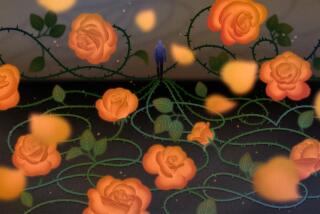Leslie Jamison connects with ‘The Empathy Exams’
The Royal Society for the Arts recently released a brilliant little animation based on a lecture by Dr. Brené Brown in which she differentiates between empathy and sympathy. In this animation, a sad fox is at the bottom of a deep, dark hole. An empathetic bear trundles down a rickety ladder into the hole, sits with the fox and says: “I know what it’s like down here, and you’re not alone.” A sympathetic gazelle peers down from the mouth of the hole, calling out: “Ooo! It’s bad, uh-huh. You want a sandwich?” The idea is that empathy is feeling with another person; sympathy creates distance, while empathy fuels connection.
In her remarkable new essay collection, “The Empathy Exams,” Leslie Jamison looks long and hard at what it means to feel empathy. “Empathy isn’t just listening to, it’s asking the questions whose answers need to be listened to. Empathy requires inquiry as much as imagination.”
Jamison, an English PhD candidate at Yale and author of the novel “The Gin Closet,” combines the intellectual rigor of a philosopher, the imagination of a novelist and a reporter’s keen eye for detail in these essays, which seamlessly blend reportage, cultural criticism, theory and memoir. Her subjects range from the journals of Frida Kahlo to documentaries about child murder and the West Memphis Three to cultural anxiety about sentimentality in art. She visits a friend in prison, travels across the U.S. border with Mexican poets and attends a conference for Morgellons (the defining symptoms of their unusual disease are “strange fibers emerging from underneath the skin” and the disbelief of most doctors). She is searching for what it means to feel pain and what it means to empathize with that feeling in others.
FULL COVERAGE: Festival of Books
Along the way, Jamison takes a hard look at her own considerable experiences of pain, ruminating on a failed heart surgery, getting her nose broken by a mugger in Nicaragua, an abortion and, more obliquely, cutting, addiction and an eating disorder. She stiches her way back and forth between her own experiences and other people’s, searching for connection.
“When bad things happened to other people,” she says in the opening essay, “I imagined them happening to me. I didn’t know if this was empathy or theft.” When Bell’s palsy leaves her brother unable to move half his face, she wonders how she would feel if this happened to her. “I obsessed, and told myself this obsession was empathy. But it wasn’t, quite. It was more like inpathy. I wasn’t expatriating myself into another life so much as importing its problems into my own.” The rest of the collection is, in a sense, her investigation of that response.
For Jamison, this means going out into the world and reporting back, as well as marshaling an absurdly impressive range of sources. She reaches for the philosophy of Martha Nussbaum or Vladimir Propp’s theory of folk tales as easily as she reaches for Brian De Palma’s “Carrie” or scientific findings in the Journal of Personality and Social Psychology.
Sometimes there is a slight tremor of anxiety in all this reaching — as if Jamison fears she will not be taken seriously — but then she coaxes these sources into unexpected juxtapositions that lead to insight. On sentimentality: “If the saccharine offers some undiluted spell of feeling … then perhaps its value lies in the process of emerging from its thrall: that sense of unmasking, that sense of guilt.” On empathy: “Empathy isn’t just something that happens to us — a meteor shower of synapses firing across the brain — it’s also a choice we make: to pay attention, to extend ourselves.”
Susan Sontag’s writing on pain (“Regarding the Pain of Others,” “Illness as Metaphor”) hums in the background of this book, and comparisons may be inevitable, but Jamison writes with far more brutal self-reflection and self-doubt. “Grand Unified Theory of Female Pain,” an astonishing essay about how we think about female pain, ends the book with an assertion difficult to imagine anywhere in Sontag’s oeuvre. After crowd-sourcing her friends and looking at “wounded women” in literature, Jamison rejects the notion that women need to deny their pain to escape the ways it has been dismissed or fetishized in the past: “I think the charges of cliché and performance offer our closed hearts too many alibis, and I want our hearts to be open. I just wrote that. I want our hearts to be open. I mean it.”
Near the end of the Royal Society for the Arts animation, Brown says, “One of the things we do, in the face of a difficult situation, is try to make things better … but the truth is, rarely can a response make something better. What makes something better is connection.” These essays do not aspire to make things better. They want us to go down into the hole and sit, to listen and ask questions, to believe in and work for connection.
Crist is writer-in-residence in biological sciences at Columbia University. She is working on a book about traumatic brain injury.
The Empathy Exams
Essays
Leslie Jamison
Graywolf: 226 pp., $15 paper
Festival of Books
What: Nonfiction: The Art of the Personal Story panel with Leo Braudy, Pico Iyer, Leslie Jamison and Dinah Lenney
When: 10:30 a.m. April 12
More info: latimes.com/festivalofbooks
More to Read
Sign up for our Book Club newsletter
Get the latest news, events and more from the Los Angeles Times Book Club, and help us get L.A. reading and talking.
You may occasionally receive promotional content from the Los Angeles Times.








